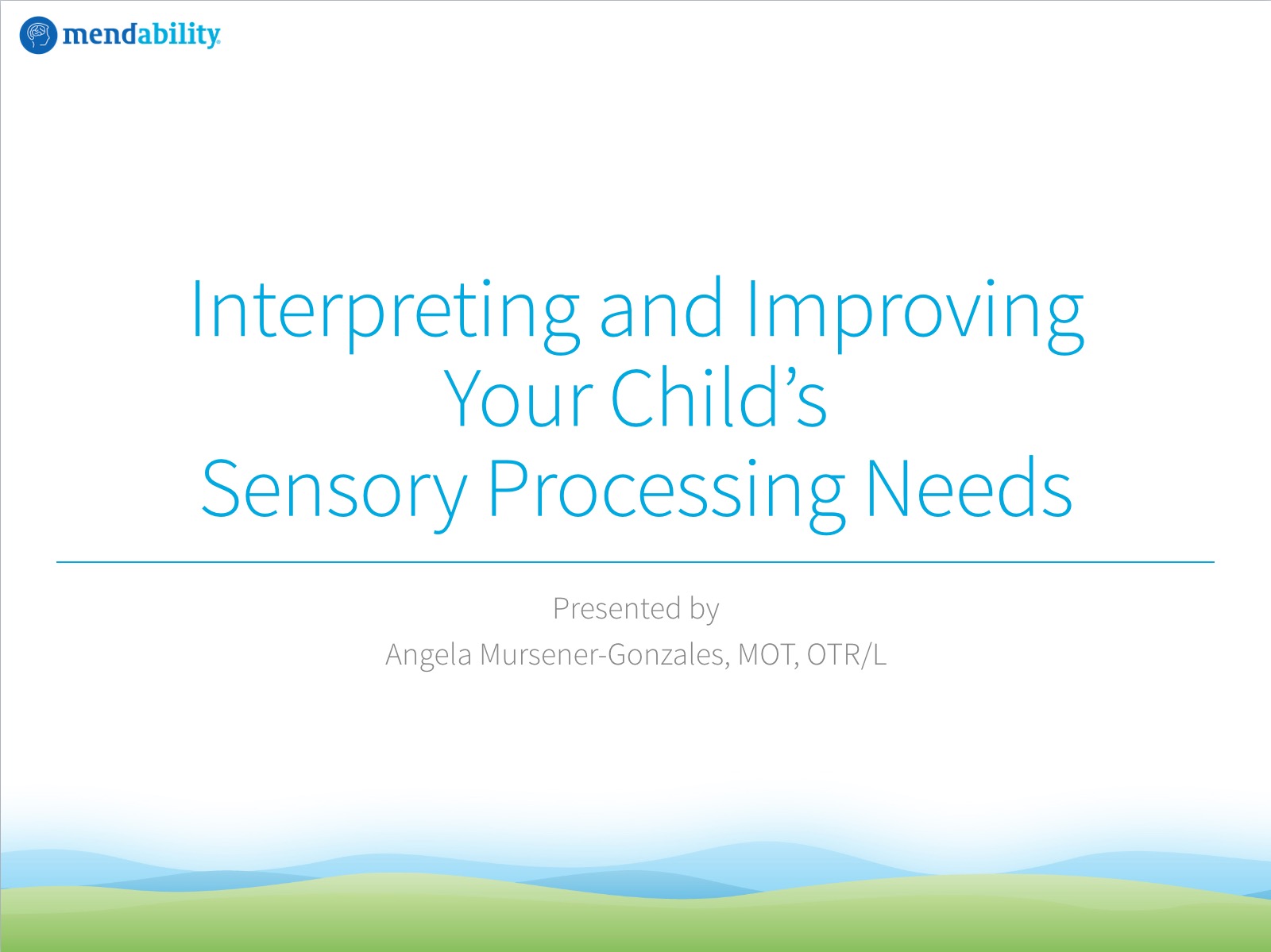About this webinar
Have you ever wondered why your loved one:
- Refuses certain foods?
- Stims on a moving object?
- Walks on her toes?
- Covers his ears?
- Has delayed responses?
It could be that he or she is experiencing sensory processing issues.
In this webinar, we:
- Examine how each of the senses plays an active role in your loved one’s autistic behaviors;
- Review current research showing how autistic symptoms may be linked to sensory processing problems;
- Discuss an effective, evidence-based therapy that can reduce these sensory processing issues.
About the speaker

Angela joined Mendability in April 2015 after learning about the remarkable benefits of Sensory Enrichment Therapy.
She obtained a master’s degree in occupational therapy from the University of Utah, focusing her training on children and neurological rehabilitation.
Angela has previously worked as a research assistant for numerous psychological studies and as a counselor for youth at a treatment facility.
Featured research
- Woo, C.C. & Leon, M. (2013). Environmental enrichment as an effective treatment for autism: A randomized controlled trial. Behavioral Neuroscience, 127, 487-497.
- Woo, C. C., Donnelly, J. H., Steinberg-Epstein, R., & Leon, M. (2015). Environmental Enrichment as a Therapy for Autism: A Clinical Trial Replication and Extension. Behavioral Neuroscience. Advance online publication.
References for this webinar
- Abu-Dahab, S. N. (2013). Motor and Tactile-Perceptual Skill Differences Between Individuals with High-Functioning Autism and Typically Developing Individuals Ages 5-21.Journal Of Autism & Developmental Disorders, 43(10), 2241-2248.
- Ashwin, C., Chapman, E., Howells, J., Rhydderch, D., Baron-Cohen, S., & Walker, I. (2014). Enhanced olfactory sensitivity in autism spectrum conditions. Molecular Autism, 5(1), 31-50. doi:10.1186/2040-2392-5-53
- Autism spectrum disorder: Signs and symptoms. (2015, February 26). Centers for Disease Control and Prevention. Retrieved from http://www.cdc.gov/ncbddd/autism/signs.html
More…
- Bennetto, L., Kuschner, E. S., & Hyman, S. L. (2007). Olfaction and taste processing in autism. Biological Psychiatry, 62(9), 1015-1021. doi:10.1016/j.biopsych.2007.04.019
- Ben-Sasson, A., Hen, L., Fluss, R., Cermak, S. A., Engel-Yeger, B. & Gal, E. (2009). A meta-analysis of sensory modulation symptoms in individuals with autism spectrum disorders. Journal of Autism and Developmental Disoreders, 39,1-11.
- Bitter, T., Siegert, F., Gudziol, H., Burmeister, H. P., Mentzel, H. J., Hummel, T., Gaser, C., & Guntinas-Lichius, O. (2011). Gray matter alterations in parosmia. Neuroscience, 177, 177-182.
- Bonnel A, Mottron L, Jelenic P, Faubert J: Enhanced pitch sensitivity in individuals with autism: a signal detection analysis. J Cogn Neurosci 2003, 15:226–235. 10.1162/089892903321208169
- Brang, D. & Ramachandran, V. S. (2010). Olfactory bulb dysgenesis, mirror neuron system dysfunction, and autonomic dysregulation as the neural basis for autism. Medical Hypotheses, 74, 919-921.
- Brock, M. E., Freuler, A., Baranek, G. T., Watson, L. R., Poe, M. D., & Sabatino, A. (2012). Temperament and sensory features of children with autism. Journal of Autism and Developmental Disorders, 42, 2271– 2284.
- Demopoulos, C., Brandes-Aitken, A. N., Desai, S. S., Hill, S. S., Antovich, A. D., Harris, J., & Marco, E. J. (2015). Shared and divergent auditory and tactile processing in children with autism and children with sensory processing dysfunction relative to typically developing peers. Journal Of The International Neuropsychological Society, 21(6), 444-454. doi:10.1017/S1355617715000387 Emilie and the autism journey. Retrieved from https://www.facebook.com/EmilieAndTheAutismJourney/?fref=nf
- ESGWNRM. (2012, July 5). A child’s view of sensory processing [Video file]. Retrieved from https://www.youtube.com/watch?v=D1G5ssZlVUw
- Feldman, R., Weller, A., Sirota, L., Eidelman, A. (2002). Skin-to-skin contact (kangaroo care) promotes self regulation in premature infants: Sleep-wake cyclicity, arousal modulation, and sustained exploration. Developmental Psychology, 38(2), 194-207.
- Gilman, S. & Newman, S. W. (2003). Essentials of clinical neuroanatomy and neurophysiology (10th ed.). Philadelphia, PA: F. A. Davis Company.
- Grandin, T. (1992). Calming effects of deep touch pressure in patients with autistic disorder, college students, and animals. Journal of Child and Adolescent Psychopharmacology, 2(1), 63-72.
- How does our sense of taste work? (2012, January 6). PubMed Health. Retrieved from http://www.ncbi.nlm.nih.gov/pubmedhealth/PMH0072592/
- Jancke, L., Shah, N. J., & Peters, M. (2000). Cortical activations in primary and secondary motor areas for complex bimanual movements in professional pianists. Cognitive Brain Research, 10, 177-183.
- Kern, J. K., Garver, C. R., Carmody, T., Andrews, A. A., Trivedi, M. H., & Mehta, J. A. (2007). Examining Sensory Quadrants in Autism. Research In Autism Spectrum Disorders, 1(2), 185-193.
- Kuschner, E. S., Eisenberg, I. W., Orionzi, B., Simmons, W. K., Kenworthy, L., Martin, A., & Wallace, G. L. (2015). A preliminary study of self-reported food selectivity in adolescents and young adults with autism spectrum disorder. Research In Autism Spectrum Disorders, 15-1653-59. doi:10.1016/j.rasd.2015.04.005
- Lang, R., Koegel, L. K., Ashbaugh, K., Regester, A., Ence, W., & Smith, W. (2010). Physical exercise and individuals with autism spectrum disorders: A systematic review. Research in Autism Spectrum Disorders, 4, 565-576.
- Marco, E. J., Hinkley, L. B. N., Hill, S. S., & Nagarajan, S. S. (2011). Sensory processing in autism: A review of neurophysiologic findings. Pediatric Research, 69(5), 48R-54R.
- Marco, E. J., Khatibi, K., Hill, S. S., Siegel, B., Arroyo, M. S., Dowling, A. F. … Nagarajan, S. S. (2012). Children with autism show reduced somatosensory response: An MEG study. Autism Research, 5(5), 340-351.
- New government survey pegs autism prevalence at 1 in 45. (2015, November 13). Autism Speaks. Retrieved from https://www.autismspeaks.org/science/science-news/new-government-survey-pegs-autism-prevalence-1-45
- Robertson, C. E., Kravitz, D. J., Freyberg, J., Baron-Cohen, S., & Baker, C. I. (2013). Tunnel vision: Sharper gradient of spatial attention in autism. The Journal Of Neuroscience, 33(16), 6776-6781. doi:10.1523/JNEUROSCI.5120-12.2013
- Schauder, K. B., Muller, C. L., Veenstra-VanderWeele, J., & Cascia, C. (2015). Genetic variation in serotonin transporter modulates tactile hyperresponsiveness in ASD. Research in Autism Spectrum Disorders,1(10), 93-100.
- Sensory processing disorder checklist. (2015). Sensory Processing Disorder Foundation. Retrieved from http://www.spdfoundation.net/about-sensory-processing-disorder/symptoms/
- Song, Y., Hakoda, Y., Sanefuji, W., & Cheng, C. (2015). Can They See It? The Functional Field of View Is Narrower in Individuals with Autism Spectrum Disorder. PloS One, 10(7), e0133237.
- SPD symptoms checklist. (2011). SPD Support. Retrieved from http://spdsupport.org/resources/symptoms.shtml
- Stoeckel, M. C., Morgenroth, F., Buetefisch, C. M., & Seitz, R. J. (2012). Differential grey matter changes in sensorimotor cortex related to exceptional fine motor skills. PLoS ONE, 7(12), e51900.
- Tavassoli, T. S. (2012). Taste Identification in Adults with Autism Spectrum Conditions. Journal Of Autism & Developmental Disorders, 42(7), 1419-1424.
- Watson, L. R., Patten, E., Baranek, G. T., Poe, M., Boyd, B. A., Freuler, A., & Lorenzi, J. (2011). Differential associations between sensory response patterns and language, social, and communication measures in children with autism or other developmental disabilities. Journal of Speech, Language, and Hearing Research, 54, 1562–1576.
- Whyatt, C. & Craig, C. (2013). Sensory-motor problems in Autism. Frontiers in Integrative Neuroscience, 7I(51), 1-12.
- Yamamoto, T. (2008). Central mechanisms of taste: Cognition, emotion, and taste-elicited behaviors. Japanese Dental Science Review, 44, 91-99.
- Zablotsky B, Black LI, Maenner MJ, et al. (2015). Estimated prevalence of autism and other developmental disabilities following questionnaire changes in the 2014 National Health Interview Survey. National health statistics reports; no 87. Hyattsville, MD: National Center for Health Statistics.
Book a Free Consultation
Schedule a convenient time to discuss your situation with one of our therapy coaches.
About Sensory Enrichment Therapy™
New research is raising the possibility that the core features of autism may be responses to sensory abnormalities. Sensory Enrichment Therapy can show you how to formulate a sensory program that will not only help them feel more comfortable and more confident in the real world, but also improve communication and social skills.
Sensory Enrichment Therapy was clinically evaluated in independent randomized controlled studies. The severity of autism improved significantly in the sensory enrichment group of children compared to controls. Results showed that 42% of the enriched children and only 7% of the control group achieved clinically significant improvement of 5 points on that scale.
This is your chance to take control of your child’s therapy and to play a vital role in your child’s development.
As you engage in sensory exercises with your child and spend time together, you will feel the emergence of a strong, new connection. Many parents report feeling a sense of fulfillment and pride, and their child can feel it too.
Perhaps one of the most rewarding experiences parents are reporting is their child’s increased ability to experience and exhibit spontaneous happiness.

